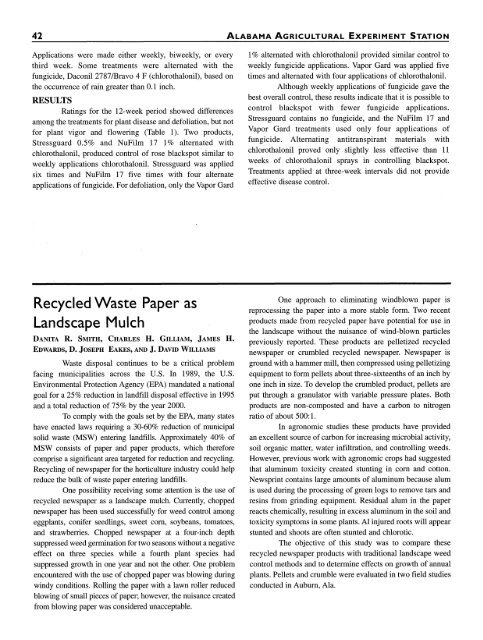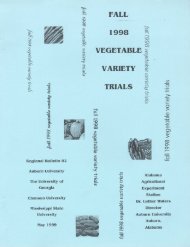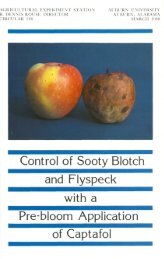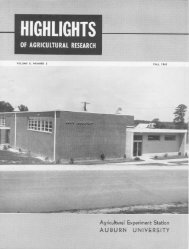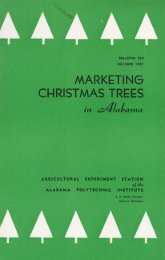1997 Ornamentals Research Report - AUrora - Auburn University
1997 Ornamentals Research Report - AUrora - Auburn University
1997 Ornamentals Research Report - AUrora - Auburn University
Create successful ePaper yourself
Turn your PDF publications into a flip-book with our unique Google optimized e-Paper software.
42<br />
42<br />
ALABAMAAGRICULTURAL ExPERIMENT STATION<br />
ALABAMA AGRICULTURAL EXPERIMENT STATION<br />
Applications were made either weekly, biweekly, or every 1% alternated with chlorothalonil provided similar control to<br />
third week. Some treatments were alternated with the weekly fungicide applications. Vapor Gard was applied five<br />
fungicide, Daconil 2787/Bravo 4 F (chlorothalonil), based on times and alternated with four applications of chlorothalonil.<br />
the occurrence of rain greater than 0.1 inch.<br />
Although weekly applications of fungicide gave the<br />
RESULTS<br />
Ratings for the 12-week period showed differences<br />
among the treatments for plant disease and defoliation, but not<br />
for plant vigor and flowering (Table 1). Two products,<br />
Stressguard 0.5% and NuFilm 17 1% alternated with<br />
chlorothalonil, produced control of rose blackspot similar to<br />
weekly applications chlorothalonil. Stressguard was applied<br />
six times and NuFilm 17 five times with four alternate<br />
applications of fungicide. For defoliation, only the Vapor Gard<br />
best overall control, these results indicate that it is possible to<br />
control blackspot with fewer fungicide applications.<br />
Stressguard contains no fungicide, and the NuFilm 17 and<br />
Vapor Gard treatments used only four applications of<br />
fungicide. Alternating antitranspirant materials with<br />
chlorothalonil proved only slightly less effective than 11<br />
weeks of chlorothalonil sprays in controlling blackspot.<br />
Treatments applied at three-week intervals did not provide<br />
effective disease control.<br />
II V ' L<br />
Recycled Waste Paper as<br />
Landscape Mulch<br />
DANITA R. SMITH, CHARLES H. GILLIAM, JAMES H.<br />
EDWARDS, D. JOSEPH EAKES, AND J. DAVID WILLIAMS<br />
Waste disposal continues to be a critical problem<br />
facing municipalities across the U.S. In 1989, the U.S.<br />
Environmental Protection Agency (EPA) mandated a national<br />
goal for a 25% reduction in landfill disposal effective in 1995<br />
and a total reduction of 75% by the year 2000.<br />
To comply with the goals set by the EPA, many states<br />
have enacted laws requiring a 30-60% reduction of municipal<br />
solid waste (MSW) entering landfills. Approximately 40% of<br />
MSW consists of paper and paper products, which therefore<br />
comprise a significant area targeted for reduction and recycling.<br />
Recycling of newspaper for the horticulture industry could help<br />
reduce the bulk of waste paper entering landfills.<br />
One possibility receiving some attention is the use of<br />
recycled newspaper as a landscape mulch. Currently, chopped<br />
newspaper has been used successfully for weed control among<br />
eggplants, conifer seedlings, sweet corn, soybeans, tomatoes,<br />
and strawberries. Chopped newspaper at a four-inch depth<br />
suppressed weed germination for two seasons without a negative<br />
effect on three species while a fourth plant species had<br />
suppressed growth in one year and not the other. One problem<br />
encountered with the use of chopped paper was blowing during<br />
windy conditions. Rolling the paper with a lawn roller reduced<br />
blowing of small pieces of paper; however, the nuisance created<br />
from blowing paper was considered unacceptable.<br />
One approach to eliminating windblown paper is<br />
reprocessing the paper into a more stable form. Two recent<br />
products made from recycled paper have potential for use in<br />
the landscape without the nuisance of wind-blown particles<br />
previously reported. These products are pelletized recycled<br />
newspaper or crumbled recycled newspaper. Newspaper is<br />
ground with a hammer mill, then compressed using pelletizing<br />
equipment to form pellets about three-sixteenths of an inch by<br />
one inch in size. To develop the crumbled product, pellets are<br />
put through a granulator with variable pressure plates. Both<br />
products are non-composted and have a carbon to nitrogen<br />
ratio of about 500:1.<br />
In agronomic studies these products have provided<br />
an excellent source of carbon for increasing microbial activity,<br />
soil organic matter, water infiltration, and controlling weeds.<br />
However, previous work with agronomic crops had suggested<br />
that aluminum toxicity created stunting in corn and cotton.<br />
Newsprint contains large amounts of aluminum because alum<br />
is used during the processing of green logs to remove tars and<br />
resins from grinding equipment. Residual alum in the paper<br />
reacts chemically, resulting in excess aluminum in the soil and<br />
toxicity symptoms in some plants. Al injured roots will appear<br />
stunted and shoots are often stunted and chlorotic.<br />
The objective of this study was to compare these<br />
recycled newspaper products with traditional landscape weed<br />
control methods and to determine effects on growth of annual<br />
plants. Pellets and crumble were evaluated in two field studies<br />
conducted in <strong>Auburn</strong>, Ala.


